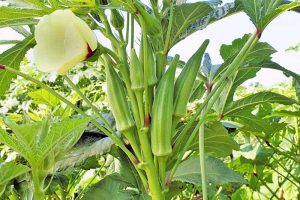- Botanical Name & Family: Abelmoschus esculentus, Malvaceae (mallow family) .
- Plant Description: Flowering plant cultivated for edible green seed pods. Exact origin debated (South Asia, Ethiopia, West Africa). Alternate, palmately lobed leaves with slimy quality when crushed. Funnel-shaped flowers. Edible part is the fruit (ovary containing seeds).
- Cultivation Tips: Thrives in warm climates with abundant sunlight (6-8 hours). Requires consistent moisture, especially during flowering/fruiting. Well-drained, fertile soil (pH 6.0-6.8). Sow seeds 2.5 cm deep, 30-45 cm apart. Fertilize regularly. Harvest pods when 5-10 cm long, tender, and immature. Regular harvesting encourages continuous production.
- Ayurvedic Description: Known as Bhindi or Lady’s Fingers. Balances all three doshas, particularly Vata and Pitta. Cooling and demulcent (slimy) properties soothe the GI tract (gastritis, leaky gut). Promotes healthy elimination, alleviates constipation. Strengthens bones, lubricates joints, supports skin/hair/nails. Aids heart health, lung health, blood sugar balance, weight loss, and has anti-cancer properties. Often cooked with balancing ingredients like coconut.

Nutritional profile of seasonal vegetable (per 100g raw edible portion):
| Vegetable | Botanical Name | Calories (kcal) | Carbohydrates (g) | Protein (g) | Fat (g) | Fiber (g) | Key Vitamins | Key Minerals |
| Bhindi (Okra) | Abelmoschus esculentus | 33 / 33 | 8 / 8 | 2 / 1.9 | 0 / 0.2 | 3 / 2.1 | C (26 mg), A (4 mcg RAE) | Ca, K, Na, Fe |
